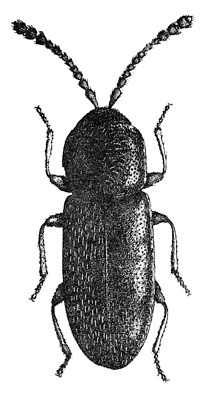Pests
Atomaria linearis Steph. - Pigmy Mangold Beetle
Systematic position.
Class Insecta, order Coleoptera, family Cryptophagidae, genus Atomaria Steph.Synonyms.
Atomaria herminea Reitter, A. pygmaea Heer, A. uhagoni Reitter.Biological group.
Pest of beet.Morphology and biology.
Adult length, 1.2-1.5 mm. Body flattened, narrow and parallel-sided, light or dark brown. Pronotum sometimes slightly darker than elytra. Frons is convex, distance between eyes and antennal base is somewhat longer than distance between antennae. Antennae are long, with 3-segmented club; 1st antennal segment 2 times as long as wide. Pronotum is square, weakly transverse, as wide as elytra. Punctation on disk of pronotum is dense and tiny. Elytral surface is slightly shagreenate. Body pubescence consists of tiny and light hairs. Tarsus 5-segmented. Egg elongate-oval, milky-whitish, 0.4-0.44 mm in diameter. Larva mainly white, with yellowish head and brownish mandibles; its integument covered with sparse and fine hairs. Head is broad and flat with protruding labrum. Body length of mature larvae is to 2.3 mm. Pupa covered with fine hairs located on small prominences. Its last abdominal segment has 2 long spicules.Distribution.
Europe northward to Scandinavia, Northern Africa, Asia Minor, Middle East, Iran, Northern America. In the former USSR, it inhabits the European part northward to Baltic States and Caucasus, Northern Kazakhstan, South of Siberia, Primorskii Territory.Ecology.
Monovoltine. Common in agrocenosis, sometimes occurring in meadows and forests. Adult hibernates in soil at a depth to 1 m or on the soil surface under litter. The first overwintered adults appear early in spring, immediately after snow thaw. They feed on last year's beet remainder and on underground parts of potato, carrot, and plants of Chenopodiaceae, Poaceae, Fabaceae. Adults occur first on the soil during daylight, but later in evening only. Beetles fly in evening time during May at air temperature about 17-19°. Oviposition lasts from May until September. Fertility is about 50 eggs. Female lays eggs near the host root system at a depth to 20-30 cm. Embryonal development lasts 5-6 days. Majority of the larvae occur at a depth of 40-60 cm. Larva and pupa development lasts 33-42 and 11-16 days, respectively. Young beetles emerge in June, but most of them appear on the soil surface in October after rains.Economic significance.
Adults damage from beet seed germination to stage of 3 pairs of true leaves. Beetles gnaw numerous small cavities on the underground parts of the seedlings. Main damage by the pest occurs during cold and moist springs, when adults stay in the soil longer than usual. In the last case about 45% of seedlings perish following drought. After the stage of 3 pairs of true leaves, the beetles feed on lateral rootlets, and their harmfulness is minimal. Control measures include distant separation of new crops from the last year's beet fields, utilization of plant remainder after harvesting, and weeding. Presowing seed treatment by pesticides shows good results too.Reference citations:
Zverezomb-Zubovskii E.V. 1957. Pests of sugar-beet. Kiev: AN Ukr.SSR. 276 pp. (in Russian)Kosolapova G.Ya. 1974. Economical significance of Cryptophagidae . In: Kosolapova G.Ya. et al., eds. Materials of the 3rd republican scientific-practical conference on plant protection in Kazakhstan. Alma-Ata: Kaz.NIIZR. p. 30-33. (in Russian)
Kubatska M. 1975. Atomaria linearis and control measures against it. In: Voronina T.I. & Lobanova G.A., eds. 8th International congress on plant protection. Moscow: Vneshtorgizdat. p. 166-172. (in Russian)
Lyubarskii G.Yu. 1992. Family Cryptophagidae. In: Ler P.A., ed. Keys to insects from the Far East of the USSR. V. 3. Coleoptera, or beetles. Part 2. St. Petersburg: Izd. Nauka. p. 245-274. (in Russian)
Malenev F.E., Nikolaeva E.F. & Stukalova N.F. 1967. Atomaria linearis in Kuban Region. Sakharnaya svyekla. N 3. Moscow: Kolos. p. 31-32. (in Russian)
Petrukha O.I., Bichuk Yu.P. & Reznik V.N. 1978. Atomaria linearis. Zashchita rastenii. N 8. p. 52-54. (in Russian)
Tril O.P. 1971. Biological proving of the control measures against Atomaria linearis. In: Danilova M.G., ed. Protection of the beet and other crops from the pests. Kiev: Izd. VNIIS. p. 226-236. (in Russian)
Ulashkevich M.I. & Komosko N.S. 1935. Atomaria linearis. Kiev-Kharkov: Gosizdat. kolkhoznoi i sovkhoznoi lit. Ukr.SSR. 39 pp. (in Russian)


